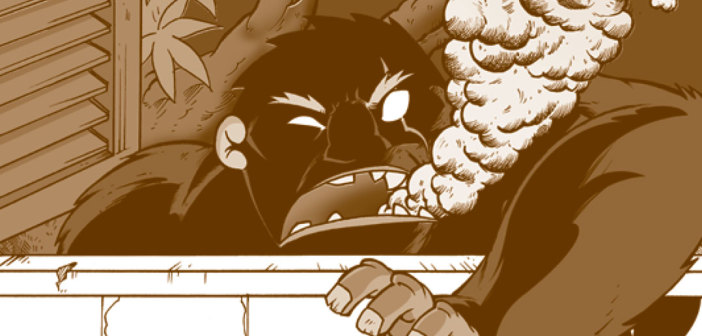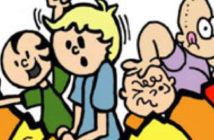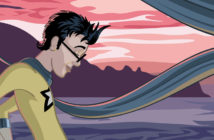If J. Torres’ and Elbert Or’s Lola: A Ghost Story demanded to have a rating assigned to it, the book comes so very close to earning four stars. The story is charming, the cast of characters is engaging (and, more importantly, believable), and the artwork is deceptively powerful. Oni Press, the publisher of Lola, is going to market the comic as a children’s book, but at its heart this tale is for anyone and everyone who enjoys literature for all ages (I hesitate to say “children’s,” as a good story should be accessible to all, transcending generational limits). It has the same far-reaching appeal that a runaway bestseller like Harry Potter once had, regardless if the intended readership is age 8 or 38.
The story of Lola revolves around Jesse, who we meet at the book’s opening during a flashback. The infant Jesse is seen with his Lola, the Tagalog term for “grandmother,” who is either trying to bathe the child, or drown it. The one-page flashback then quickly cuts to the present: Jesse is now an adolescent, who is embarking on a trip with his parents from Canada to their native homeland of the Philippines, where they will attend the funeral of Lola, who has recently died.
The arrival of Jesse and his family in the Philippines opens the door to a layered reflection of human truth and myth, as Torres and Or are constantly presenting us with the harsh facts of reality juxtaposed against the cathartic workings of the imagination. They are greeted by Uncle Tim and his children, Maritess and Jon-Jon, as they roll up to the family’s luxurious estate, which has been owned by the bloodline for generations due to a lucrative pig farm. Legend has it that the farm came into being after Lola received a ghostly vision that helped direct her family’s fortune. But it’s just a story, isn’t it?
As Jesse’s visit unfolds, several fairytales and ghost stories are passed along; they’re all innocuous enough when considered one at a time, but these tales lend an eloquence that bolsters the blurred borders between reality and imagination. Every story affects the consciousness of Jesse in some way, a boy who is not common for his age. He’s not brash, nor a brat; he’s reluctant and introspective, a contemplative kid who is certain he’s cursed with the ability to see otherworldly beings. If this is true or not is irrelevant: perhaps Jesse does possess some kind of supernatural ability, or maybe he’s a creative savant far beyond his years. Regardless, Jesse is a youngster trying to discover his place in a world colored by surreal folklore.
The artwork of Elbert Or adds deceptive visual depth to the book. As the story moves along at a steady pace, Or’s art is simple and carefree. But when reality falls away and is replaced by fantasy, Or takes care with his images, adding find details to his whimsical scenes. Consider, for example, a panel where Jesse is staring attentively at a crucifix hanging on the wall of his uncle’s home—the details that Or draws into the body of Christ are intriguing to admire. Later on in the story, there’s an ape creature tormenting Jesse, which is crawling through the window of his bedroom. The beast is breathing plumes of finely detailed smoke, and the windowsill it’s reaching over is cracked and stained. Or not only controls the page, but he controls us, too.
But despite all that is wonderful about Lola, there’s one unavoidable flaw that prevents it from earning a perfect four-star rating. I can’t give it away, but the final page of the book is completely contradictory to every page that unfolds before it. When it appears that all of the plot threads in Lola make peace with themselves and end on an uplifting note, a dreadful curveball is thrown that comes across as a cheap gimmick rather than the tricky twist I believe it was intended to be. The final caption box reads “The End?”—the question mark caused me to say aloud, “What is the writer thinking?” Such a conclusion is completely out of character with the rest of the book, which is wonderful.
Lola: A Ghost Story may not be deserving of four stars, but it has certainly earned three and a half for being an overall worthwhile and enchanting tale for all ages, just not kids. There were times while I was reading this story that I was reminded of the magic I felt upon reading Clive Barker’s The Thief of Always and seeing Guillermo del Toro’s Pan’s Labyrinth for the first time. All of these stories successfully question where the threads of fantasy end and those of actuality begin.
This comic book review originally appeared on Broken Frontier on 16 January 2010.




